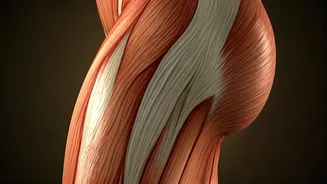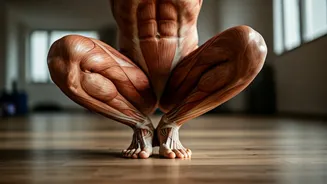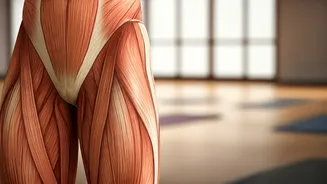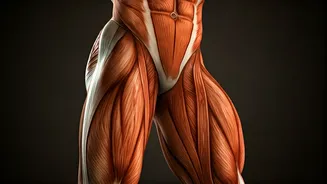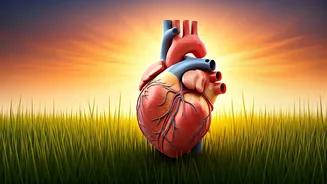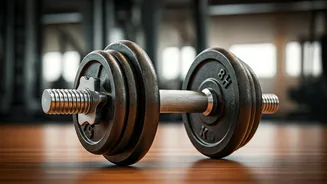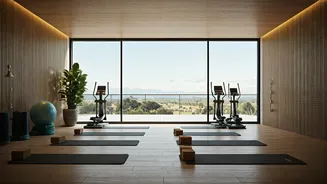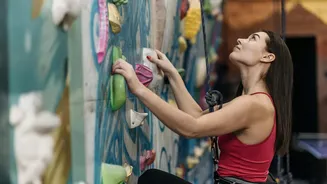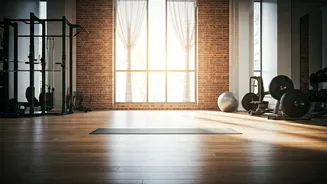Thighs and Longevity
The health of your thighs plays a surprisingly significant role in your overall well-being and lifespan. Strong thighs contribute to better balance, improved
mobility, and increased metabolic health. As we age, maintaining muscle mass becomes crucial, and the muscles in your thighs are among the largest in your body. They are vital for everyday activities like walking, standing, and climbing stairs. Keeping these muscles strong through regular exercise can help prevent falls, reduce the risk of chronic diseases, and enhance your quality of life. This means that focusing on exercises that target your thighs can be a proactive step towards a longer and healthier life. Incorporating activities that engage these muscles is an investment in your future well-being, making it easier to stay active and independent as you grow older. Regular exercise for your thighs improves blood flow, which in turn benefits overall cardiovascular health.
Standing Shalabhasana
Standing Shalabhasana, or the Standing Locust Pose, is an effective way to strengthen your thighs and improve posture. To perform this asana, begin by standing tall with your feet hip-width apart and your arms at your sides. Engage your core and lift your chest, keeping your spine straight. Inhale deeply and as you exhale, bend forward from your hips, keeping your back straight and your core engaged. Raise your arms parallel to the floor, palms facing down. Now, lift one leg straight back, keeping it in line with your torso. Maintain balance by keeping your gaze forward. Hold the pose for a few breaths, feeling the stretch in your hamstrings and the engagement in your thighs. Repeat on the other side. This asana strengthens not just the thighs but also the back muscles, improving overall body alignment. It enhances balance, boosts circulation, and can reduce lower back pain. Regularly practicing this pose can also help improve flexibility and coordination, making it a valuable addition to your fitness routine. Remember to listen to your body and modify the pose if needed to avoid overexertion.
Utkatasana Squat
Utkatasana, often known as the Chair Pose, is an excellent exercise for building strength in your thighs and glutes. To begin, stand with your feet hip-width apart and your arms extended in front of you at shoulder height. Inhale deeply, and as you exhale, bend your knees as if you are sitting in a chair. Keep your back straight, chest lifted, and core engaged. Your thighs should be parallel to the floor if possible, and your weight should be in your heels. Hold the pose for several breaths, focusing on engaging your thigh muscles. Keep your gaze forward to maintain balance. The Chair Pose significantly strengthens your quadriceps, hamstrings, and core muscles. It improves balance and promotes greater flexibility in the ankles and hips. Practicing this asana regularly not only helps build muscle mass but also improves endurance. It can be easily adapted to different fitness levels, making it accessible for everyone. Remember to focus on your form to get the most benefits and avoid injury.
Deviasana Squat
Deviasana, or the Goddess Pose Squat, is another powerful asana that effectively targets the thighs and opens the hips. Start by standing with your feet wider than shoulder-width apart, toes pointing outwards. Bend your knees, lowering your hips as if you are about to sit, keeping your back straight and chest lifted. Your knees should be aligned with your ankles, and your thighs should be parallel to the floor, if possible. Bring your arms up, bending your elbows and positioning your forearms as if you were holding a bowl. Hold the pose and breathe deeply, feeling the stretch in your inner thighs and the engagement in your quads and glutes. The Goddess Pose is fantastic for strengthening your legs and opening your hips, making it easier to achieve a deeper squat. It also promotes better posture and improves balance. Regular practice can enhance flexibility and can reduce tension in the hips and groin, offering both physical and mental benefits. Pay attention to your form, ensuring that your knees are aligned with your ankles to protect them from injury.
